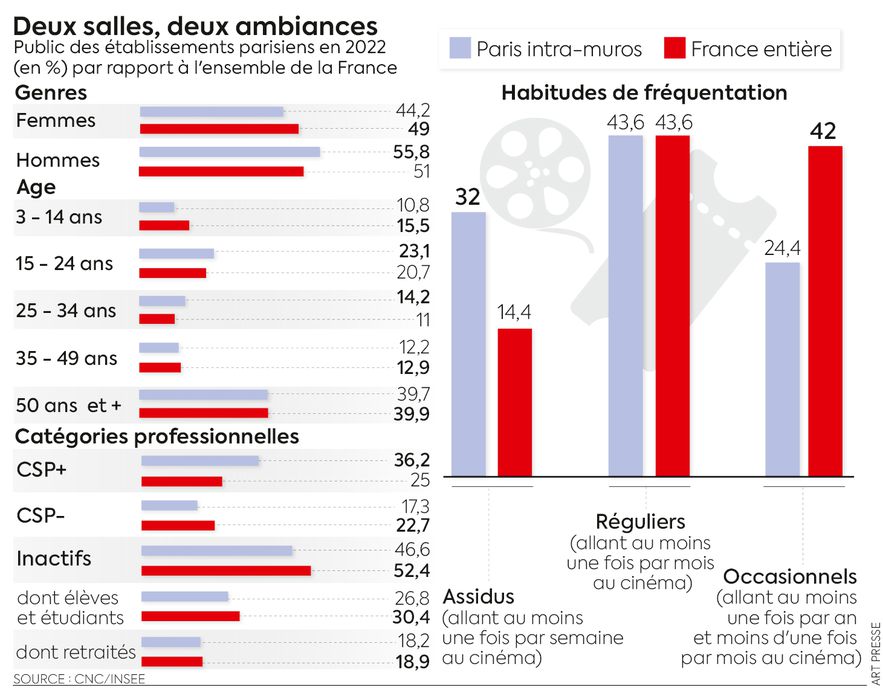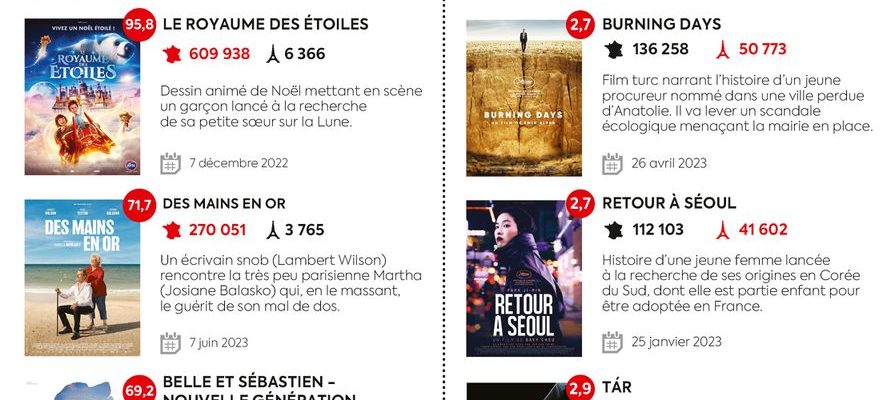Of course, there is GDP. Prices per square meter. Industrial production and the balance of payments. And then there are the hidden indicators, a priori anecdotal, but which say a lot about a nation and the fault lines that affect it. You have to go and find these in the good mushroom spots. For example in cinema box offices. We find, in these austere tables for initiates, a column soberly entitled “coefficient”. This quotient measures, for each film, the proportion between “Whole France” admissions and those recorded in the capital’s cinemas. Over the last year, its average stands at 9.5. “The lower the coefficient, the more the success of the film is above all Parisian. The higher it is, the more the film was popular outside the capital and shunned in Paris,” summarizes Eric Marti, general director of Comscore France, the company which aggregates these valuable indicators every week.
The history of this coefficient, its evolutions, its “records” document years of cultural tectonics. Are we going to see the same films in Paris and in the provinces (1)? What are the genres that distinguish us the most? How do we explain these differences? Exclusively for L’Express, Comscore ran its software, and extracted from its archives a table going from 2015 to today, i.e. more than 6,600 films, of which we retained a list of around 1,700 feature-length films. films with more than 100,000 entries. First conclusion: we are going to see the same films less and less. Thus, the number of provincial boxes ignored by Paris (films whose coefficient exceeded 20) represented 12% of the box office in 2016, compared to 23% in 2022 (2). Mainly French comedies, family or heritage films. In 2023, these provincial blockbusters – about which the national media generally talk little – are called Toto’s Jokes 2, Hands of goldwhich tells the story of a rich Parisian writer cared for by a colorful Josiane Balasko, Les Petites Victoires, Belle and Sebastien New Generation, or Les Déguns 2.
What ? The Déguns ? This means nothing to you ? Sévrine Breil, urban director of Pathé cinemas in Marseille, can tell you about it: she was marked by the long queues during the release of this second opus in the Marseille city, on July 19 – a week before the rest of France. Spectators won over, an eclectic audience “aged from 12 to 60 years old”, and rooms “packed” for more than two weeks. Made famous in 2014 on YouTube by a web series, the actor duo Karim Jebli and Nordine Salhi narrates the adventures of two Marseillais (one of Moroccan origin, the other of Tunisian origin) in the Sauvagère district.
“For the premiere of the film, the four theaters were filled in a few minutes,” says the director. Since its release, the feature film has received more than 506,000 admissions throughout France. But in Paris itself less than 7,500 people passed through the door of a cinema to follow the second part of the adventures of the Déguns (literally: the less than nothing), which was only broadcast in a handful of theaters. Since 2015, the films that have broken coefficient records are often on the same model: Bodin’s in Thailand – the second opus of this duo which tenderly depicts a mother and her peasant son – holds the record in the history of the coefficient: 589! The two parts of Municipal (156 and 191), written and produced by the Knights of Gall, also prance.
Different successes in Paris and the rest of France.
© / Art Press
Specific audiences
How can we explain such a gap between the capital and the rest of France? “The first thing to take into account is obviously the difference in the offering, whether in number of establishments or types of films broadcast,” explains Olivier Alexandre, sociologist specializing in cinema. research fellow at the CNRS. According to recent figures published by the National Center for Cinema and Animated Images (CNC), Paris indeed concentrates a significant number of large screens: 400 in 2022, grouped in 77 establishments, including 37 classified arthouse. The attendance index is also much higher in the capital than in the rest of France: it stands at 7.28 admissions per year per inhabitant in 2022, compared to 2.29 for the national average.
The Parisian public also presents different specificities compared to the rest of France in terms of age and socio-professional categories.. “In summary, Paris concentrates the most cinema-loving population in France, a less family-oriented audience, a share of CSP+ well above the national average, more frequent spectators, and access to establishments, particularly those classified as arthouse, extremely developed “It should be noted that this category of spectators is also found in the city centers of major French metropolises”, summarizes Olivier Alexandre. Outside of large cities, where on average we find a more casual, more family-oriented audience, more exposed to transport issues, the sociologist believes that “spectators will take fewer risks on the film they are going to see”. “From the start, the intention is not the same: we favor a form of entertainment, with popular comedies or family films, without subtitles, which we have potentially heard about on television or radio, promise of a pleasant moment with actors that we know and who we know will meet our expectations,” he explains.
The presence of certain actors on the poster often constitutes the first marker of these parallel quests. “There are actors who are very identified with auteur cinema, just as there are figures from popular comedies, with their own style and their own audience,” explains Brigitte Rollet, researcher specializing in cinema. “Isabelle Nanty [NDLR : que l’on retrouve dans les quatre volets des Tuche]like others, comes from television, a great provider of movie stars, but from Canal + and not from TF1″, she illustrates. “We are lucky to have several generations of very identified actors outside of Paris which bring people back to theaters, adds François Clerc, president of Apollo Films, which notably distributed The Déguns, The Segpa, the two parts of Municipal. This is the case of Franck Dubosc, for example, of the actors of Splendid, of Bande à Fifi, of Dany Boon…” Life for realthe latest feature film starring the actor Ch’timi and his sidekick Kad Merad, released in April 2023, brought together more than 810,000 spectators across France… including only 40,000 in Paris, a coefficient of 20 ,2.
“We replay the relationship between the supposedly educated guy and the simpleton”
For Brigitte Rollet, part of the explanation is also found in the scripts of these successful films. “In many of these works, like those of Bodin’s, The Tuches Or Welcome to the Ch’tis, we replay a lot the relationship between the worker and the boss, the provincial and the Parisian, the supposedly educated guy and the simpleton, which has existed for a very long time. We already found it in the opposition of Funès-Bourvil for example”, she remarks. Last parameter, the heritage aspect of the film or its setting. “People like it when the story they discover connects to something personal, settings close to home, problems they experience on a daily basis, explains François Clerc. It is not trivial if The Déguns are experiencing incredible success in Marseille, if a large part of the entries of Belle and Sebastian are done in the Rhône-Alpes region, if the public of Municipal is more Occitan,” he believes.
Jérôme Hilal, founder of the production company Zinc., which notably distributed Small Victories (Alice’s story, mayor and teacher of the small village of Kerguen, in Brittany, who strives to preserve essential services there, and sees an atrabilarian sixty-year-old played by Michel Blanc arrive in his class) abounds: “The public recognizes itself in the films which resemble, who speak of him.” This feature film, as well as the film In the name of the earth (released in 2019 and which portrays an over-indebted farmer played by Guillaume Canet), are among the biggest successes of the Régency arthouse cinema, directed by Laurent Coët in Saint-Pol-Sur-Ternoise (Pas-de-Calais). “They’re not really popular comedies or family films, but the story spoke to people here. Not to those in Paris. Conversely, if I had programmed The Déguns, I would hardly have had any spectators,” he explains.
Well aware of these territorial affinities, professionals have developed adapted communication strategies. For Small Victories (935,502 entries in France, including just under 26,000 in Paris), which addresses the issues of rural desertification, the production company Zinc. organized a five-month preview tour in 110 towns and villages in France. “For the rest, we are obviously dependent on the exhibitors: we wanted to release the film everywhere, but the Parisian theaters deemed it ‘rural’. As a result, we released it on 365 prints… including only 8 in Paris itself. “, testifies Jérôme Hilal, the boss of Zinc. same for me Hands of gold, also distributed by his company. “It was only released on two copies, compared to more than 400 in the rest of France – where it was a success, with more than 270,000 admissions.” According to Comscore data, the intramural Paris/province coefficient of this latest feature film amounts to 71.7.

Two rooms, two atmospheres.
© / Art Press
“Self-fulfilling prophecy”
This coefficient is scrutinized by distribution professionals, who make it an element of their distribution strategy. David Baudry, director of programming for CGR cinemas – which operates 74 establishments in France, all located outside Paris – says he spends his time “analyzing tables, figures, histories, and making estimates”. “By getting to know our audiences, I know where very popular films will be appreciated, where it is better to broadcast a lot of blockbusters, where the Palme d’Or risks selling out or failing.” Even if it means frustrating a certain part of the public. Or to trigger “self-fulfilling prophecy” mechanisms. “You work with comparables: for example, you gauge Yannick in light of Quentin Dupieux’s previous films, or The Nun 2 in the light of its first part, and you realize that there can be typologies of films that are more Parisian and others more provincial.” Even if the specialist insists on the need to “program all categories of films in all [leurs] cinemas”, for example by broadcasting “the original version or more difficult films in certain establishments in order to offer an ever richer and more varied offering to all spectators”.
The fact remains that a cultural tectonic is at work. Its result is that we share less and less the same mental universes. Because cinema, like song or literature, is the stuff from which we make nations: common representations, shared references, common tears and collective laughter… Cinema makes society vibrate less and less in unison. It is now archipelagoized, like the rest. And the asymmetry of the treatment of films in the national press (some which were hits in the provinces are barely mentioned by critics) doesn’t help matters. It reinforces the idea of two Frances which no longer speak to each other, and are no longer interested in each other.
There remain, of course, a few films that everyone agrees on. Latest example: the summer success ofOppenheimer, three-hour film by Christopher Nolan about the inventor of the atomic bomb. With nearly 475,500 entries into the capital out of 4,259,692 total entries into France, its coefficient amounts to 9 – right on average. Sometimes you just need the movie to be good.
(1) We do not resign ourselves to using the fashionable volapük of “regions” or “territories”. But don’t misinterpret: we are two provincials.
(2) Always taking as a basis films with more than 100,000 admissions.
